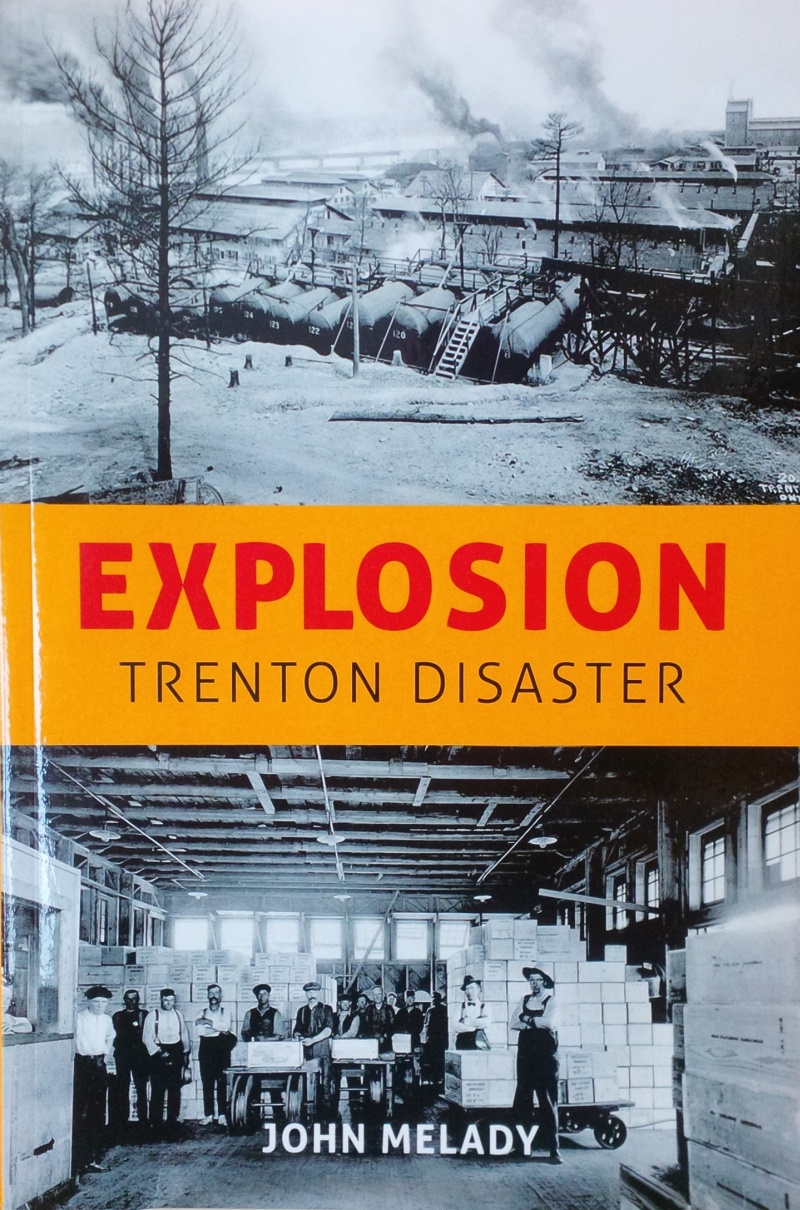TRENTON’S THANKSGIVING DISASTER by BARNEY MOORHOUSE
Sitting in the blazing afternoon sun, watching a couple of CC- 130J model “Super” Hercules climbing from take-off in the background, I couldn’t help but reflect upon that Thanksgiving night in 1918 when the term thanksgiving took on an entirely new meaning as the Trenton area skies were ablaze with explosions that hopefully will never be repeated. The contrast stared me in the face.
But I am getting ahead of myself.
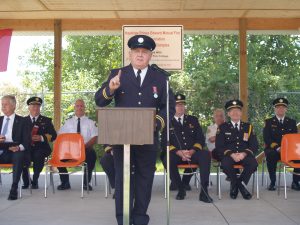
On July 10, at 1:00 p.m., we were in Trenton to hear dignitaries officially “re-open” the Hastings-Prince Edward Counties Mutual Fire Aid Association’s Training Complex, a facility in the making for three decades. Primarily a fire fighting training facility, it is also used by police, EMS, Military and municipal workers. Fire fighters train and become certified here in compliance with the Ontario Fire Marshal’s Office. Training costs are reduced by 75% for the 1000+ full time and volunteer members. The Master of Ceremonies, Mutual Aid President Chuck Naphan, a 30 year volunteer, enthusiastically provided some historical perspective and introduced many of the guest speakers. When he described the modern facility as a place to save lives, “not to take lives”, he highlighted the positive irony of this day’s celebratory gathering.
THANKSGIVING DAY 1918
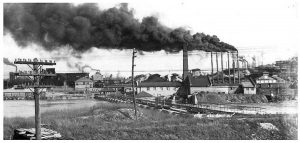
During WW1 Trenton was home to a major munitions plant – “the largest ammunition factory, at the time, in the Commonwealth” – owned by the British Chemical Company. Built in 1915 to manufacture artillery, rifle, and small arms ammunition, it covered some 255 acres. With but 3 weeks before the Armistice a series of explosions literally obliterated the place.
“There wasn’t a single pane of glass left unshattered in Trenton” said Naphan.
What happened?
Industry was attracted to Trenton’s waterways and cheap hydro-electric power. Highway 2 was the main trans-provincial road, rail service connected Trenton to communities and industries throughout North America, the Trent River provided fresh water and boat access plus the telephone and telegraph services were reliable. “At one time the plant employed 3000 workers at $3.00 a day – excellent wages for the time,” said Naphan.
The T.N.T. (trinitrotoluene) plant was built on the NE slopes of Bunker Hill. The 5 plants comprising this B.C.C. property produced, on a monthly basis, 8 million pounds of sulphuric acid, 5 million pounds of nitric acid, 2 million, two hundred thousand pounds of pyro-cotton, 1.5 million pounds of nitro-cellulose powder and one million, 2 hundred thousand pounds of T.N.T.
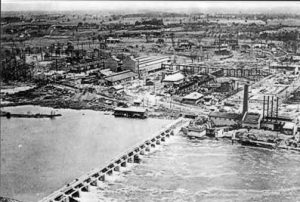
Safe working conditions were not what they are to-day. In his very readable book, “Explosion – Trenton Disaster”, author John Melady wrote: “The poor bugger didn’t have a chance. I’ll never forget seeing that,” quoting one worker’s memory of an employee dying on the job from boiling acid. At a later time, men cleaning the plant site found zippers from pants in the drained acid tanks. One can only wonder how many men fell in and perished?
“Acid fumes bleached colour out of clothing, rubber boots turned white and fruit tree farmers were compensated for losses due to the poisoned air.”
By 1917 the munitions plant was in full production for the war effort. TNT moved east by rail. Readers may recall the horrendous Halifax explosion of December 6, 1917, when the SS Mont-Blanc, a French cargo ship, fully loaded with TNT, exploded killing some 2000 people and wounding 9000. It has been described as the largest man-made explosion prior to the development of nuclear weapons. The TNT came from Trenton.
THANKSGIVING WEEKEND October 12-14, 1918
WW1 was winding down and for the first time since it entered into munitions production the facility shut down for a holiday with only a skeleton crew on hand. On October 14 a chemical plant employee set off an irreversible reaction that triggered an explosion which sent workers fleeing for their lives. Train engineer Joe Barry was later credited with saving Trenton from a fate similar to Halifax when he hooked up an engine to two box cars full of TNT and travelled through dense smoke and acid fumes to escape the area. A series of increasing explosions, no less than 8, prevented any plant rescue. As night descended a red glow lit up the night sky. “80% of Trenton was evacuated,” said Naphan, referring to the town’s mass exodus.
The Intelligencer in Belleville reported that it was a miracle that noone was killed. But a report in the Perth Courier thought otherwise.
One of the most shocking tragedies to effect Perth in recent years was the explosion in the plant of the British Chemical Company at Trenton exactly at 1:45 Friday morning last, in which three Perth boys lost their lives. Philip Doynes MacDonnell, son of Mr. and Mrs. P.J.C. MacDonnell, Perth; Edwin Charles Noonan, son of Mr. H.T. Noonan, Perth, and James Bernard Smith, son of Mr. and Mrs. Thomas Smith, Perth. These three boys went to Trenton only the previous Wednesday and engaged with the Chemical Company, commencing work on the night of the following Thursday. The explosion occurred a couple of hours later after commencing work in a small separate building known as the “solvent, recovery” department… MacDonnell, Smith were either stunned or killed outright, were burned in the building. Edwin Noonan was thrown some forty feet in the air… Edwin Noonan experienced terrible burns, his body being a mass of burns from the waist to the head and face.

As earlier mentioned WW1 soon came to a conclusion. The armistice between the Allies and Germany – also known as the “Armistice of Compiègne” after the location where it was signed – was the agreement that ended the fighting in western Europe that comprised the First World War. It went into effect at 11 a.m. on 11 November 1918, and marked a victory for the Allies and a complete defeat for Germany, although not technically a surrender.
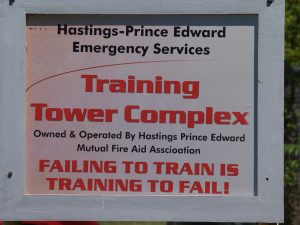
If you are into conspiracy theories you will also find Melady’s book of interest. Was this really accidental? Why was the enquiry so shallow? Was there a cover-up? With the war coming to an end there would be no need for this plant. Was this a way to get rid of it? Did that explain why the plant shut down for the first time?
I borrowed the book at my local library. If this has piqued an interest you may wish to read it for yourself.
July 10, 2014
In his address, Chuck Naphan emphasized that this facility is on land that once manufactured munitions designed to take lives; now it proactively trains to save lives. Its motto clearly expresses this sentiment: “Failing to Train is Training to Fail.”
Guest speaker, Ontario’s Fire Marshall Ted Wieclawek, enthusiastically welcomed this facility as an affiliate of the Ontario Fire College. With ever diminishing financial resources such initiatives help meet the challenge of ever increasing needs.
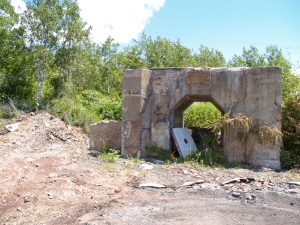
Oh, and Bunker Hill? Some have credited it too with saving Trenton from a fate similar to Halifax. And, as recently as July 1, 2014, although the Trenton fireworks display was rather spectacular it must have paled when compared to that night sky of Thanksgiving 1918.
2015
